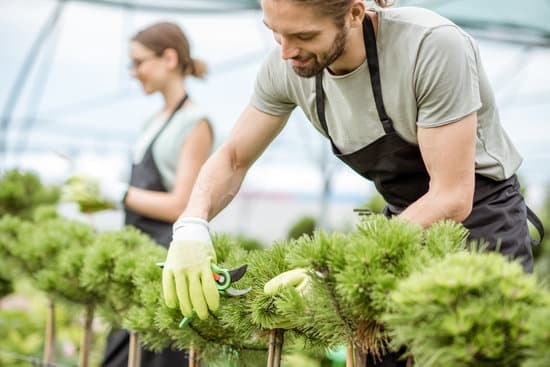Are you looking to bring a touch of greenery into your living space? Plant combination ideas for indoor container gardens can be the perfect solution to add some life and color to your home. Indoor container gardens not only enhance the aesthetic appeal of your space but also offer numerous benefits such as improving air quality, reducing stress, and boosting your mood.
By carefully selecting the right plants and arranging them in appealing combinations, you can create a mini oasis inside your home. Whether you have a sunny windowsill or a cozy corner with minimal light, there are plant combinations that will thrive in various environments indoors. From tropical ferns to colorful blooms, the possibilities for creating beautiful indoor gardens are endless.
In this article, we will explore different plant combinations for indoor container gardens that cater to various light conditions and space constraints. We will also delve into how mixing plants with different colors and textures can elevate the visual appeal of your indoor garden. So, get ready to unleash your creativity and transform your living space into a green paradise with these plant combination ideas.
Choosing the Right Container
When setting up an indoor container garden, selecting the right containers is crucial to the success of your plants. There are various types of containers available, each with their own advantages and considerations. Here are some options to consider when choosing the perfect container for your indoor garden:
- Terra Cotta Pots: These classic pots are porous, allowing for good airflow to the plant’s roots. However, they may require more frequent watering due to their ability to absorb moisture.
- Plastic Pots: Lightweight and affordable, plastic pots are easy to move around and come in a variety of sizes and colors. They don’t dry out as quickly as terracotta pots.
- Ceramic Pots: These stylish pots add a decorative touch to your indoor space. Keep in mind that ceramic pots are heavier and may be more fragile than other options.
- Hanging Baskets: Ideal for small trailing plants or herbs, hanging baskets save floor space and add visual interest when suspended from the ceiling or a window ledge.
- Self-Watering Containers: Perfect for those who tend to forget about watering their plants, self-watering containers have reservoirs that supply water to the plant as needed.
In addition to considering the material and style of a container, it is essential to choose the right size for your plants. A container that is too small can restrict root growth, leading to stunted growth or even plant death.
On the other hand, a container that is too large can hold excess water, potentially causing root rot. Always select a container that allows for proper drainage by ensuring it has holes at the bottom or adding a layer of gravel before potting your plants.
Now that you have an idea of the different types of containers available and how to choose the best one for your indoor garden needs, you can start planning out the perfect plant combination ideas for indoor container gardens. Whether you opt for terracotta pots with succulents or hanging baskets with trailing vines, make sure your containers complement both your home decor and the needs of your plants.
With the right combination of containers and plants, you can create a beautiful oasis inside your home.
Light and Space Requirements
When creating an indoor container garden, it is essential to consider the light and space requirements of the plants you choose. Understanding the sunlight needs of different plant varieties will help ensure they thrive indoors. Some plants require bright, direct sunlight, while others can tolerate lower light conditions. It’s important to place your indoor container garden in a location that offers the appropriate amount of natural light for the plants you have selected.
Sunlight Needs
Plants like succulents and cacti thrive in bright, direct sunlight and should be placed near sunny windowsills where they can soak up the sun’s rays. On the other hand, ferns and peace lilies prefer indirect light and will do well in areas with filtered or low light conditions. By matching your plants’ sunlight needs with their placement in your home, you can ensure they receive the right amount of light to stay healthy and vibrant.
Space Requirements
In addition to sunlight needs, it is important to consider the space requirements of the plants in your indoor container garden. Some plants like trailing vines or cascading foliage may need more room to spread out, while compact varieties can thrive in smaller containers.
Make sure to choose containers that are large enough to accommodate the growth of your plants without crowding them. By providing adequate space for each plant, you can create a harmonious environment where all your plant combinations can flourish.
Tips for Success
To ensure the success of your indoor container garden, regularly monitor the amount of sunlight it receives and adjust as needed based on the needs of your plants. Rotate your plants every so often to promote even growth and prevent them from leaning towards one direction due to uneven light exposure.
Consider using reflective surfaces or artificial grow lights to supplement natural light if necessary, especially during darker winter months. By understanding and meeting the light and space requirements of different plant varieties, you can create a thriving indoor container garden filled with beautiful plant combination ideas for any home.
Best Plant Combinations for Low Light Environments
When it comes to creating a thriving indoor container garden in low light environments, selecting the right plant combinations is essential. Fortunately, there are plenty of beautiful and resilient plants that can flourish even with minimal natural light. Here are some plant combination ideas for indoor container gardens that do well in areas with low light:
- Snake Plant (Sansevieria) and ZZ Plant (Zamioculcas zamiifolia): Both of these plants are exceptionally low maintenance and can tolerate low light conditions. The sleek, upright leaves of the Snake Plant contrast beautifully with the shiny, waxy foliage of the ZZ Plant.
- Peace Lily (Spathiphyllum) and Chinese Evergreen (Aglaonema): The Peace Lily’s elegant white flowers and glossy green leaves pair perfectly with the striking variegated foliage of the Chinese Evergreen. Both plants thrive in shady spots and help purify the air indoors.
- Cast Iron Plant (Aspidistra elatior) and English Ivy (Hedera helix): The Cast Iron Plant is known for its ability to survive in dark corners with little water, making it an excellent choice for low light areas. Pair it with cascading English Ivy for a lush, textured look.
These plant combinations not only add visual interest to your indoor space but also bring life and vibrancy to areas that may lack natural sunlight. Experimenting with different textures, sizes, and colors will allow you to create a diverse indoor garden that thrives despite limited light availability.
Remember to consider the specific care requirements of each plant in your chosen combination, including watering schedules, humidity levels, and soil preferences. With proper maintenance and attention to detail, you can enjoy a flourishing indoor container garden filled with greenery and beauty, even in low light environments.
Best Plant Combinations for Sunny Windowsills
Sunny windowsills provide a perfect spot for plants that thrive in bright, natural light. When it comes to selecting plant combinations for such locations, there are a variety of options to consider. One popular choice is pairing succulents with herbs.
Succulents, known for their ability to withstand sunny conditions and store water in their leaves, can be complemented by aromatic herbs like rosemary, thyme, or basil. Not only do these combinations look visually appealing together, but they also offer the added benefit of having fresh herbs on hand for cooking.
Another great plant combination idea for sunny windowsills is mixing flowering plants with trailing vines. Consider pairing colorful geraniums or petunias with cascading plants like pothos or ivy. This combination not only adds a pop of color to your indoor space but also creates a dynamic visual contrast between the upright flowers and the trailing vines. Additionally, the vines can help fill any empty spaces and add depth to your windowsill garden.
For those looking to create a tropical oasis on their sunny windowsill, combining palms with orchids can be a stunning option. Palms thrive in bright light conditions and add a touch of greenery reminiscent of a tropical paradise. Pairing them with delicate orchids in vibrant colors can create a beautiful and exotic display.
Be sure to provide proper care for both plants by ensuring they receive adequate sunlight and humidity levels to maintain their health and beauty. In conclusion, there are endless possibilities when it comes to creating plant combination ideas for indoor container gardens on sunny windowsills – get creative and have fun experimenting with different pairings to find what works best for your space.
Seasonal Plant Combinations
When creating an indoor container garden, one way to keep it exciting and vibrant is by changing up the plant combinations according to the season. This not only keeps your space visually appealing but also ensures that your plants are thriving in optimal conditions. For example, during the spring and summer months, you might want to consider pairing colorful flowers like petunias or geraniums with lush green foliage plants to create a refreshing and lively display in your indoor garden.
As the seasons transition into fall and winter, you can switch up your plant combinations to include varieties that thrive in lower light conditions and cooler temperatures. Plants like peace lilies, snake plants, or pothos vines are excellent choices for indoor container gardens during these months. Their ability to adapt to varying light levels makes them perfect for keeping your indoor garden looking fresh even when natural light is scarce.
Moreover, incorporating seasonal elements like decorative pumpkins or pine cones can add a festive touch to your indoor container garden during the fall and winter holidays. These additions not only enhance the overall aesthetic but also bring a sense of coziness and warmth to your living space. By rotating plant combinations based on the seasons, you can keep your indoor garden dynamic and engaging throughout the year while providing a stimulating environment for both yourself and your plants.
| Season | Ideal Plant Combinations |
|---|---|
| Spring/Summer | Petunias + Geraniums + Foliage Plants |
| Fall/Winter | Peace Lilies + Snake Plants + Pothos Vines |
Color and Texture Pairings
Color and texture play a crucial role in creating visually appealing indoor container gardens. Combining plants with different colors and textures can add depth, interest, and personality to your indoor space. When selecting plants for your indoor garden, consider how their colors and textures will complement each other to achieve a harmonious overall look.
One effective plant combination idea for indoor container gardens is pairing lush, green foliage plants with bright flowering varieties. For example, you can mix the vibrant blooms of African violets with the rich green leaves of Boston ferns to create a striking contrast. Additionally, combining spiky succulents with trailing vines can add an interesting textural element to your indoor garden.
Another approach to color and texture pairings is to choose plants that have similar hues but varying textures. For instance, pairing smooth-leaved peace lilies with fuzzy-leafed begonias can create a visually pleasing composition. By incorporating plants with diverse textures, you can create a tactile experience in addition to visual interest in your indoor container garden.
To further enhance the visual appeal of your indoor garden, consider incorporating plants with variegated foliage or unique patterns. Mixing variegated spider plants with striped snake plants can add a dynamic element to your plant combinations. Experimenting with different color and texture pairings allows you to create a personalized indoor container garden that reflects your style and aesthetic preferences.
| Plant Combination | Description |
|---|---|
| African violets + Boston ferns | Combining vibrant blooms with rich green leaves for contrast |
| Succulents + trailing vines | Pairing spiky succulents with trailing vines for textural variety |
| Peace lilies + begonias | Mixing smooth-leaved peace lilies with fuzzy-leafed begonias for contrast |
Tips for Maintaining Healthy Plant Combinations
In conclusion, creating beautiful and thriving indoor container gardens involves more than just choosing the right plants and containers. To ensure your plant combination ideas for indoor container gardens flourish, it is essential to understand the maintenance aspect. Proper watering, fertilizing, and pruning are crucial to the health and happiness of your indoor plants.
Watering is key to keeping your plants healthy. Overwatering can lead to root rot, while underwatering can cause wilting and stunted growth. Finding the right balance by checking soil moisture regularly and adjusting watering frequency accordingly is vital for maintaining healthy plant combinations in your indoor garden.
In addition to watering, fertilizing is important for providing essential nutrients to your plants. Different types of plants have varying fertilizer needs, so it is essential to research and tailor your fertilizing schedule accordingly. Regular pruning also plays a significant role in maintaining healthy plant combinations.
Removing dead or diseased foliage not only improves the aesthetic appeal of your indoor garden but also promotes new growth and overall plant health. By following these tips for maintaining healthy plant combinations, you can enjoy a vibrant and flourishing indoor container garden all year round.
Frequently Asked Questions
What Indoor Plants Go Well Together in Pots?
Different indoor plants can thrive together in pots as long as they have similar light, water, and soil requirements. For example, pairing a peace lily with a pothos can create a nice contrast in textures and heights. Similarly, combining succulents like echeveria with snake plants can make an aesthetically pleasing arrangement.
What Vegetables Grow Well Together in a Container?
When it comes to growing vegetables together in containers, it’s essential to consider their individual needs. For instance, tomatoes, basil, and marigolds can be planted together in the same container as they benefit from each other’s presence. Carrots and radishes are also compatible companions in containers due to their different root depths.
What Plants Go Well Together in a Planter Box?
Planters boxes offer the opportunity to create beautiful combinations of plants based on sunlight exposure and watering needs. For example, grouping together herbs like rosemary, thyme, and oregano works well in a planter box placed in a sunny spot.
Mixing colorful flowers like petunias with trailing vines like sweet potato vine can also add visual interest to a planter box arrangement.

Welcome to my gardening blog! I am passionate about plants and enjoy sharing my knowledge and experiences with others. In this blog, I will write about everything related to gardening, from tips on how to get started to updates on my own garden projects.





